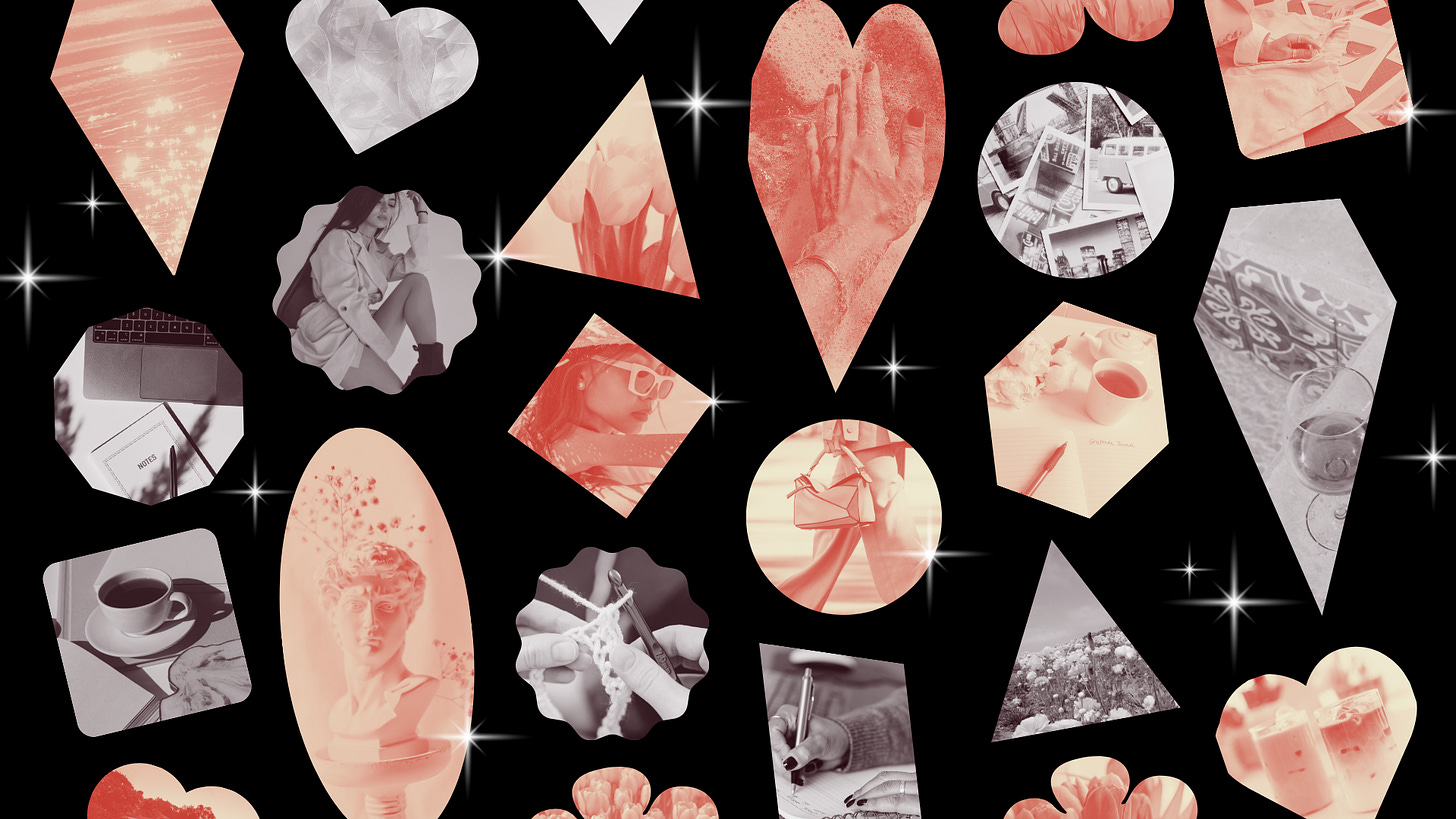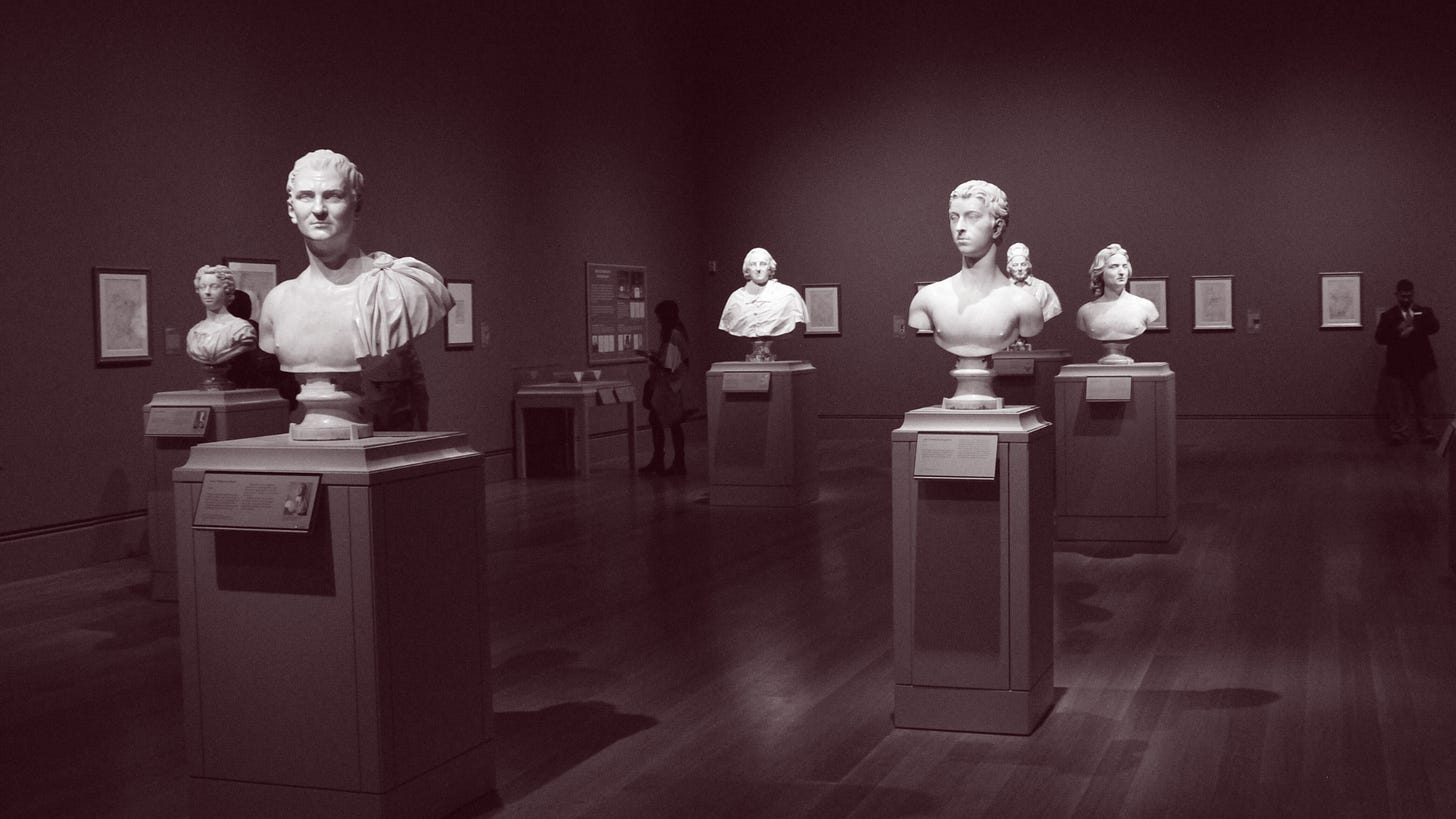How Curation Helps Us Makes Sense Of the Internet
And, with sites like Pinterest and Tumblr, anyone can curate to a certain degree.
Hi everyone!
The Manila heat is insane. I’ve been hiding from the sun in my bedroom while trying to get over a bug I caught over the weekend.
This retreat into complete darkness (I keep the curtains drawn and never turn the lights on) left me with a lot of time to scroll through apps on my phone. One app I’ve been spending a lot of time with recently is Pinterest. In typical ZERO PERCENT SUGAR fashion, I used it as a jumping-off point for this week’s article. Hope you enjoy it!
Estimated reading time: 8 minutes
Pinterest is my sanctuary. Unlike Instagram, Twitter, and TikTok, Pinterest doesn’t pressure us to create original and premeditated images for consumption. The website, instead, encourages us to “pin” our favorite images from around the Internet to “boards” we create. The content on Pinterest isn’t as clickbait-y as Instagram reels and YouTube videos. While scrolling through Instagram feels like downing a gallon of the energy drink du jour, being on Pinterest resembles sipping a warm cup of tea.
Pinterest lets users lead with choice. When I pin something to my mood board, it means that something about that image resonated with me. Curating these boards is another way of expressing our tastes and sensibilities online. Maintaining these boards is also a huge time and effort investment, but it’s still less time than filming a talking head video.
Curating gives us an alternate way of presenting ourselves online by selecting and maintaining vast amounts of media we did not create. It directs our attention to looking after our online consumption. How did we end up here?
A Brief History Of Curating
All this talk of curation as caretaking isn’t new. The word itself comes from the Latin root “cura,” which means “to care for.” The words “cure” and “secure” also trace their origins back to “cura”.
The first curators were Roman bureaucrats who presided over governmental departments. Over the centuries, “curator” evolved into a title for positions of authority in museums, galleries, and other cultural institutions. Like their Roman predecessors, museum and art curators take care of their designated collections by preserving the museum collection, conducting research, and educating the public about the history of the work.
Hans Ulrich Obrist, the co-director at the Serpentine Galleries in London, compiled A Brief History of Curating, which recounts the development of curation as a profession through interviews with esteemed practitioners. The informal format of Obrist’s book also reveals something difficult to stomach: that, despite professionalization, the role of a curator is still as nebulous as ever. A curator needs to be a project manager, a researcher, an educator, and an art handler, all at once.
Now, the title extends beyond the realm of museums and galleries. In their journal article, Curation as a Social Practice: Counter-Narratives in Public Space, researchers Torsten Kathke, Juliane Tomann, and Mirko Uhlig explore how curation bleeds outside the confines of academia and art. They write, “Almost anything can be subject to curation, from Instagram accounts and Spotify playlists to the collections of a favorite team’s branded jerseys, or one’s own wardrobe.” While scrolling around job websites, I’ve seen postings for “content curators” or “digital design curators.” And, with sites like Pinterest and Tumblr, anyone can curate to a certain degree.
When Everyone’s A Curator…
The term’s present-day ubiquity raises issues about the nature of curation. In her article, Everyone’s a Curator. That’s Not (Always) a Bad Thing, art writer Alina Cohen investigates the “broadening (or bastardization, depending on whom you ask) of the word ‘curator.’” While the title transcended its antiquated background, the term shouldn’t be used liberally. Cohen writes, “These days, even your home decor can be “curated,” which suggests that anyone with decent taste in end tables has an expertise that’s on par with art history Ph.D.’s.” In other words, the title has evolved into a self-aggrandizing buzzword for those who misuse it.
The inclusion of non-art history Ph.D. graduates as curators presents opportunities to welcome fresh perspectives barred by traditional gatekeepers. Cohen interviews Kimberly Drew who started a Tumblr, Black Contemporary Art. Drew used her platform as a springboard for a role as a social media manager at The Met. She states of her relationship with the word curator: “It’s really a word that’s much more about ‘care’ than anything else. I am definitely a curator in that sense.” Cohen also touches on digital exhibition initiatives from online arts publication Rhizome and the New Museum. “They don’t fetishize any objects,” Cohen argues. “since the exhibited art is available to anyone with a wifi connection.”
Migrating some traditional art world practices online opens up the space for new voices and practices. Cohen notes the availability of images on the Internet as a democratizing force behind online art curation. The number of images, whether of fine art or not, is another reason why digital versions of this role are in demand.
Making Sense of Stuff
The need for curators in fields like technology and commerce stems from the sheer amount of stuff at our fingertips. 95 million photographs are uploaded and shared on Instagram per day. Spotify’s music catalog spans over 100 million songs. Pinterest sets a whopping 200,000-pin upload and a 2,000-board cap for each account. On a more personal note, I have over ten thousand pictures in my camera roll, and hundreds of thousands more wasting away in my hard drive. Our society’s obsession with creating content results in overlooking the importance of making sense of the mess.
Curators take the form of those who many deem to have good taste. Publications like The Strategist, Refinery29, and Buzzfeed employ a team of writers and editors well-versed in culture, taste, and trends to create listicles of clothes we should buy, movies we should watch, and memes we should know. Bloggers such as Mina Le and Anthony Fantano (both with radically different styles and audiences) cherry-pick what they show their viewers and leave well-researched reviews. But, a human can only do so much with an eternity’s supply of information and media.
Big Tech uses algorithms and artificial intelligence to craft unique recommendations for individuals. Spotify’s daylist feature creates a playlist for a specific time of the day based on the music we tend to listen to during that time frame. Instagram’s algorithm filters and highlights the most relevant posts on our feed and explores pages based on what we already like. Netflix operates similarly, with its Watch Next list. Technology managed to put curation on overdrive by focusing on the nitty-gritty selection process.
While these digital curators (I use this term very lightly) make choices for us based on data, they leave out the most important and overlooked, part of curation. Curation is the process of putting things together to spark conversation, to make us think. Cohen interviews a handful of cultural workers from various backgrounds, yet most of them highlight “making connections” as a vital skill in curating. Masterful creation facilitates the connection of ideas, while social media algorithms put us in an echo chamber. To make an analogy: algorithms see the trees, but professional curators see the forest.
Unfortunately, we’ve gotten too used to having algorithms mold our taste through piecemeal methods. If we continue down this route, we’d miss opportunities for debate and critical thought. More importantly, we’d go down the path of churning out more and more stuff of questionable quality.
So, what now? 🤷🏽♀️
We don’t need to anoint ourselves as curators to reap the benefits of the practice. As an artist, I know that curators make or break the whole process of setting up an exhibit. The best ones I worked with were excellent leaders and even better listeners. They move with purpose and ensure that every decision they make — from the color of the labels to the name of the exhibit — serves a larger, nobler goal. The general population could learn a thing, or two (or three).
How could we infuse our daily lives with curatorial intention? Curator Glenn Adamson outlines a few steps in his Psyche article, How to curate (just about) anything. Although Adamson explains the fatigue surrounding the term, he also sees its popularity as a sign that people want to curate. Adamson lists a few tips, like investing in storage and letting objects breathe. My favorite tip has to be “buy with intention.”
Adamson admits that going through an institutional checklist won’t translate well to department store shopping. However, I’m of the mind that we should run through personal criteria before we welcome things into our lives. This practice not only curbs impulse spending but also asks us to commit to long-term care for our belongings. Hopefully, this habit could translate to how we consume and create information online.
I recently limited my time on Instagram and other social media platforms that court controversy (see: Twitter, especially after the TTPD release). These restrictions showed me that seeing a hundred posts a minute isn’t a benchmark for productivity, knowledge, and expertise. I spent more time on Substack and Pinterest, where I could focus on higher-quality media that challenged my thinking (Substack) and helped me get my life together (Pinterest).
If you want to take this online curation practice further, I recommend Sane and Objet. Sane lets users curate digital gardens, while Objet allows users to upload images of their things and write a small summary. Both encourage slowing down to make sense of the Internet noise. Both are great pieces of opinionated tech that embody the sensibilities we so desperately need now.
🦋 This Fortnight’s Inspo 🦋
Books: I’m still marinating in Little Women. But, I read this New York Times essay on Anthony Fantano (also known as theneedledrop on YouTube), a music critic. He recently uploaded a not-so-positive review on The Tortured Poets Department, which made its way to my Twitter feed. As someone who writes criticism, I enjoy looking at reviews of other critics (even if I often disagree with them).
Videos: I binged most of the 0-100-year-old videos in one sitting. Each video features a clip of a different person, aged 0 to 100, saying their age. I found the collection of videos both haunting and moving. Here’s one with cats.
Art: My favorite fashion house of all time, Maison Margiela, went viral for their runway makeup looks by the inimitable Pat McGrath recently. If you haven’t seen it yet, you should.





curation ftw 🥂
I love this. I feel like my life has been so much better since pulling back from the noise of the Internet as a whole and very carefully curating what I'm exposed to. It's been great for my mental health not to be bombarded with the content of every single influencer out there, and ngl it also feels a little bit powerful to block access to my eyes/attention to a huge chunk of the Internet. The feeling of choosing what I can and will not see is soooo heady lmao.
Good read, Maddy!